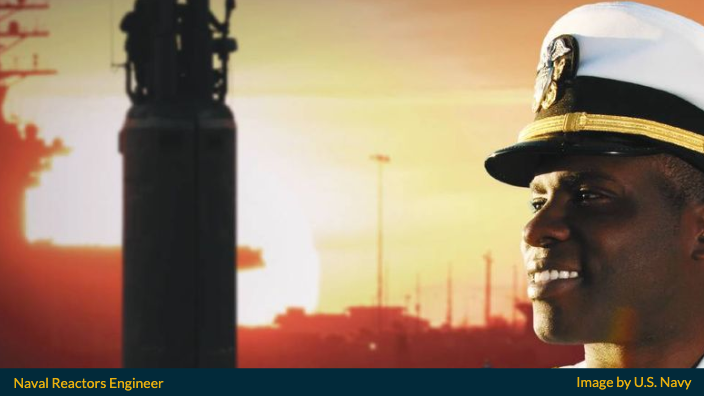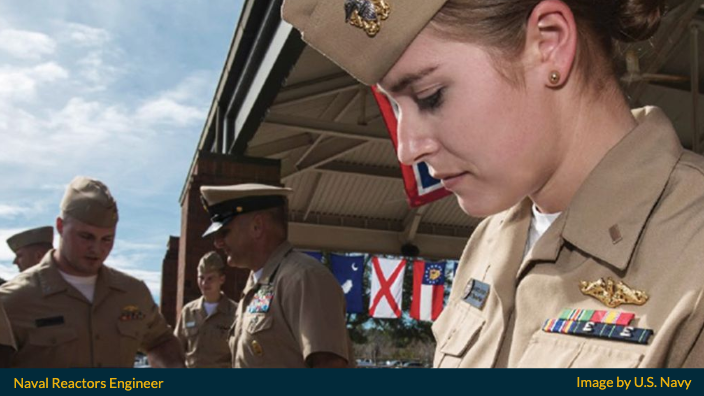This guide provides useful information that will help with your decision to become a Naval Nuclear Reactors Engineer during Fiscal Year 2025.
Naval Nuclear Reactor Engineers are Restricted Line Officers in the Navy who oversee all aspects of the Navy Nuclear Propulsion Program in Washington, D.C. The Navy Officer designator code for Naval Reactor Engineer is 1220.
As you will see, this program is very specialized and reserved for our country’s top talents.
Let us dive right in.
Nuclear Reactors Engineer Job Description

The most powerful energy on Earth needs the sharpest minds to keep it in check.
Nuclear Reactor Engineers don’t just design reactors. They study them, refine them, and keep them running on the ships and subs that define modern naval power. No room for error. No time for hesitation.
They don’t follow the standards—they set them. Pushing nuclear propulsion further. Locking down reactor safety. Leading cutting-edge research.
These engineers command the reactors that power the strongest fleet on the planet. And they don’t sit back—they chase down the hardest academic and technical challenges out there.
It’s not just engineering. It’s national security. It’s innovation. It’s teamwork that turns theory into action.
And while others in their field wait years for real responsibility, they take it on from day one.
Specific Responsibilities
Naval Reactors Engineers run the show when it comes to the Navy’s nuclear fleet. Ships, subs, shore-based prototypes, support facilities—if it’s nuclear-powered, they’re in charge.
The job pulls from every corner of engineering:
- Reactor and fluid system design
- Reactor physics
- Advanced materials
- Steam generators, pumps, valves—you name it
- Instrumentation and control systems
- Testing, shielding, chemistry, radiological controls
- Quality assurance, top to bottom
From concept to decommissioning, they oversee it all. Reactor design, fleet operations, refueling, dismantling warships—every step is under their watch. And they do it from Naval Reactors Headquarters in D.C., where the best and brightest engineers push nuclear propulsion forward.
The scale? Massive. Two Department of Energy labs. Two nuclear training sites. Nearly 100 nuclear-powered vessels. Six shipyards. Over 1,000 companies feeding into the program. It’s a high-speed, high-stakes environment where multiple projects run at once.
And while most engineers in the private sector wait years to get hands-on with critical systems, these officers jump in from day one.
What to Expect
Naval Reactors Headquarters. Washington, D.C. That’s where it all starts.
A small, elite team—just 500 people—overseeing the entire Naval Nuclear Propulsion Program. Every reactor. Every ship. Every operation. Start to finish.
The work is demanding. The stakes are high. But so is the reward. You’ll take on critical tasks alongside the best minds in nuclear engineering. Not just theory: real-world application.
It’s a path that moves fast. From post-grad-level academic study to hands-on training with prototype reactors. You’ll visit nuclear-powered vessels, inspect operations firsthand, and work with top industry leaders. No uniform required, but the mission is clear.
The experience? Unmatched. The impact? Unquestionable. The work? Classified.
Precision and discretion aren’t suggestions—they’re requirements.
Post-Service Opportunities
Nuclear Navy experience builds a different kind of mind—sharp, disciplined, but flexible enough to tackle problems no one else can crack.
These officers don’t just follow instructions. They lead. Whatever the challenge, whatever the mission, they step up.
The Navy takes raw intellect, character, and drive and forges it into real-world skill. Technical mastery. Leadership under pressure.
After four to five years, doors open.
High-level research, teaching, consulting—leadership roles in and out of uniform.
Civilian opportunities? Plenty. Many pay more. But few match the depth of experience gained here.
Navy Nuclear Officer Ranks
| Pay Grade | Navy Rank | Abbreviation |
| O-1 | Ensign | ENS |
| O-2 | Lieutenant Junior Grade | LTJG |
| O-3 | Lieutenant | LT |
| O-4 | Lieutenant Commander | LCDR |
| O-5 | Commander | CDR |
| O-6 | Captain | CAPT |
| O-7 | Rear Admiral (Lower Half) | RDML |
| O-8 | Rear Admiral (Upper Half) | RADM |
| O-9 | Vice Admiral | VADM |
| O-10 | Admiral | ADM |
How It Breaks Down:
- O-1 to O-3: Brand-new officers start at Ensign (O-1). By Lieutenant (O-3), they’re leading teams, running divisions.
- O-4 to O-6: Lieutenant Commanders (O-4) take on bigger roles. Commanders (O-5) lead departments. Captains (O-6) run ships, major shore units.
- O-7 to O-10: Rear Admirals (O-7, O-8) call the shots on strike groups and big operations. Vice Admirals (O-9) and full Admirals (O-10) run entire fleets.
This is Navy-specific. The other branches do it differently.
Salary and Benefits
2025 U.S. Navy Officer Pay Chart (First Six Years)
| Pay Grade | <2 Years | Over 2 Years | Over 3 Years | Over 4 Years | Over 6 Years |
| O-1 | $3,998.40 | $4,161.90 | $5,031.30 | $5,031.30 | $5,031.30 |
| O-2 | $4,606.80 | $5,246.70 | $6,042.90 | $6,247.20 | $6,375.30 |
| O-3 | $5,331.60 | $6,044.10 | $6,522.60 | $7,112.40 | $7,453.80 |
| O-4 | $6,064.20 | $7,019.70 | $7,488.90 | $7,592.40 | $8,027.10 |
| O-5 | $7,028.40 | $7,917.30 | $8,465.40 | $8,568.60 | $8,910.90 |
Notes:
- A 4.5% pay raise is effective January 1, 2025.
- Officers with 4+ years of prior enlisted or warrant officer service (O-1E, O-2E, O-3E) earn more. Example: O-1E (4+ years) makes $5,031.30 monthly.
- Future pay changes depend on legislation. Check DFAS.mil for updates.
Additional Pays and Allowances
- Basic Allowance for Housing (BAH): Covers housing costs for those living off-base. Amount depends on rank, location, and dependents.
- Basic Allowance for Subsistence (BAS): Helps cover meal costs. 2025 officer rate: $323.87/month.
- Hazardous Duty Incentive Pay (HDIP): Extra pay for dangerous jobs—flight decks, EOD, etc. $150–$250/month.
- Career Sea Pay: For shipboard or deployed sailors. $50–$750/month, based on rank and time at sea.
- Special & Incentive Pays: Extra cash for specific skills (e.g., air traffic control, language proficiency). Ranges from a few hundred to several thousand dollars annually.
- Nuclear Officer Bonus and Incentive Pay (NOBIP): Nuclear-trained officers can receive $35,000 – $45,000 per year based on contract length and years of commissioned service. (mynavyhr.navy.mil)
- Shift Engineer Incentive Pay (SEIP): Officers serving as shift engineers receive an additional $1,000 per month. (secnav.navy.mil)
- Overseas Cost of Living Allowance (COLA): Extra pay to offset higher living costs in foreign duty stations. Varies by location, rank, and dependents.
Benefits
- Healthcare: Free medical and dental for active duty. Low-cost TRICARE options for families.
- Housing: On-base housing or tax-free BAH for off-base living.
- Food: BAS provides a monthly food stipend.
- Blended Retirement System (BRS): Pension + Thrift Savings Plan (TSP) contributions. Retirement pay kicks in at 20 years.
- Education: Tuition assistance, Post-9/11 GI Bill, and Navy College Program support higher education.
- Life Insurance: SGLI covers up to $500,000.
- Vacation: 30 days of paid leave per year, plus federal holidays.
All rates and benefits are subject to change with future legislation.
How to Become a Naval Nuclear Reactors Engineer

To become a Naval Nuclear Reactors Engineer, applicants must be American citizens who are 19 to 29 years old at the time of commissioning with at least a bachelor’s degree in a qualifying technical field and a highly competitive grade point average (GPA).
Applicants must also have satisfactorily completed specific calculus-based courses to qualify.
Navy Nuclear Propulsion is a doorway to industry leadership and lifelong learning for qualified college graduates. Breakthrough research and high-level civilian participation.
Work that stretches well beyond the military to have an influence on the rest of the world.
All of the above is available to current undergraduate students who satisfy the required background, particularly those pursuing chosen areas such as mathematics, engineering, physics, or chemistry.
And after you graduate, you will be able to apply for a career as a recognized professional and Naval Officer with one of the world’s most successful nuclear programs.
Following the Naval Reactors Engineer course will provide you with an advanced education and expedited hands-on experience that you will not find anywhere else.
The specifics are listed below.
Naval Nuclear Reactors Engineer Basic Eligibility
| Citizenship | Applicants must be United States citizens. |
| Age | Applicants must be at least 19 years old and under 29 years old at the time of commissioning. Waivers may be considered on a case-by-case basis for individuals who will be under the age of 31 at the time of commissioning. |
| Gender | This program has no gender restrictions. |
| Marital Status | This program has no marital status restrictions. |
| Physical | In accordance with the Restricted Line criteria established in Chapter 15 of the Medical Department Manual. Prior to commissioning as a nuclear officer, program participants must satisfy the medical criteria for nuclear field duty/ionizing radiation. |
| Education | Candidates must be graduates or students seeking a BS or MS degree from an accredited college or university in the United States or a United States territory (majoring in engineering, mathematics, chemistry, physics, or other technical areas). Those still in school may apply as early as their junior year of college, and must have: Completed one academic year of college-level calculus Completed one academic year of college-level calculus-based physics Earned a competitive GPA and a minimum grade of “B” in all technical courses |
Also Read: Navy OCS Guide for Officer Applicants
NUPOC Interview
All students who apply to the Navy Nuclear Propulsion Officer Candidate (NUPOC) program are subjected to a stringent screening procedure before being chosen for a personal interview with the Director of Naval Reactors in Washington, D.C.
The first portion of the interview involves technical questions from calculus, physics, and other technical disciplines.
The bulk of the questions are from calculus and physics, but you may be questioned about other areas in your major as well.
This section of the interview usually lasts 30–40 minutes and includes two to four key questions every session.
The second round of the interview procedure included meeting with the Admiral in charge of the Naval Nuclear Propulsion program.
During this interview, the Admiral will go through your transcripts and technical interview assessments, as well as analyze your communication skills, interests, and enthusiasm for the program.
All potential Nuclear Officers are hand-picked by the Admiral.
VIP Tour
If you are a qualifying Nuclear Propulsion Officer candidate, the Navy provides a two-day VIP excursion to immerse you in this environment.
You will get the chance to explore the flight deck of an aircraft carrier or the torpedo chamber of a submarine. Interact with and question existing and potential Officers.
You will also learn about the Navy’s long history and its nuclear program.
This is your opportunity to see firsthand what it is like to start your career as a Nuclear Officer in the Navy.
Navy Nuclear Reactors Officer Training
Following graduation from college, the formal training procedure for becoming an Officer in the Naval Nuclear Propulsion program begins.
Officer Development School (ODS) — a five-week training in Newport, RI that gives a complete and intensive introduction to the duties of becoming a Navy Officer – is the first step for anyone interested in becoming a Naval Reactors Engineer.
Following the conclusion of ODS, newly commissioned Officers go to the advanced training that is at the heart of Navy Nuclear Propulsion.
Naval Reactors Engineers may anticipate to spend the next five years in charge of the Navy’s shore-based prototypes, shipboard nuclear power plants, and nuclear propulsion support facilities.
The rigorous training they get prepares them to work alongside some of the country’s finest and brightest technical specialists.
Preliminary Training: Naval Reactors Headquarters (NR)
Officers will spend the first four to five months of their careers at the Naval Reactors Headquarters in Washington, D.C., completing preparatory training.
This is followed by around two weeks of training at one of the Navy’s land-based prototypes in either Charleston, SC, or Albany, NY.
Naval Reactors Training Program (NRTP)
The next phase is a six-month postgraduate-level study in nuclear engineering at the Bettis Atomic Power Laboratory in Pittsburgh, PA, via the Bettis Reactor Engineering School.
Staff Assignment: Naval Reactors Headquarters (NR)
Following Naval Reactors Training, Naval Reactors Engineers are assigned to the group in charge of administering all technical elements of the Naval Nuclear Propulsion program, including designing, authorizing, and verifying the design, operation, and maintenance of approximately 100 nuclear reactors.
Engineers begin in a subordinate position, reporting to a supervisor, and quickly ascend to take on increased responsibility.
More Information
If you want more information about becoming a Navy Nuclear Reactors Engineer, the next logical step is to contact a Naval Officer Recruiter.
Let us start figuring out how you can benefit from becoming a Naval Reactors Engineer – or if it is even the right career move for you.
Others also read more information from our articles about other closely related Nuclear Officer jobs, such as the Nuclear Surface Warfare Officer program and the Navy Submarine Officer program.
You might also be interested to read:
Hope you found this helpful to your career planning.

